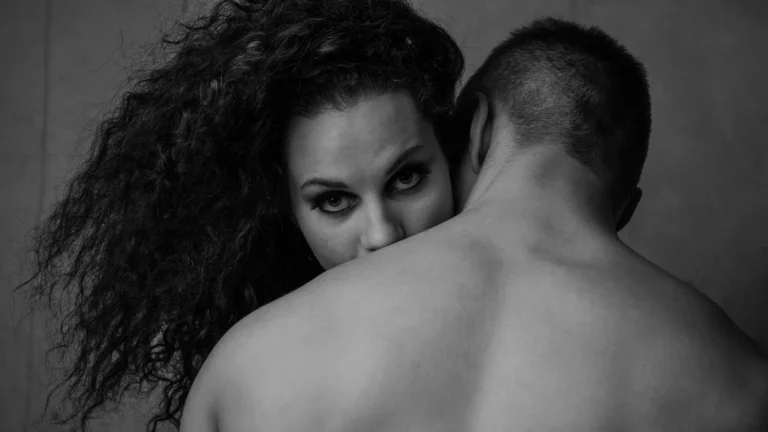Explore the basics of Shibari rope bondage art, from simple knots to intricate tying techniques, and discover its beauty, safety, and intimacy.
Shibari, the Japanese art of rope bondage, is more than just a method of restraint—it’s a visual, physical, and emotional experience. Originating in Japan from the martial art of Hojojutsu, Shibari has evolved into a modern erotic and artistic practice. This guide will take you through the basics of Shibari, covering its history, essential techniques, safety considerations, and the emotional depth it offers.
The History and Origins of Shibari
Shibari’s roots are deep in Japanese history, tracing back to Hojojutsu, a martial art used to bind prisoners with ropes. Over time, this evolved into the erotic and artistic form of rope bondage we know today as Shibari. The aesthetic of tying knots and binding the human form has transcended into a means of self-expression, connection, and exploration of power dynamics between partners.
What is Shibari?
Shibari allows for movement, even when the bottom is fully restrained. The ropes create tension that can accentuate body flexibility, enabling the bottom to arch or move within their limits.
Shibari, meaning “to tie” in Japanese, is a type of rope bondage where intricate knots and patterns are used to bind the body. While some see it as an erotic practice, others view it as an artistic expression, with the human body becoming the canvas for the rope work.
The Evolution of Shibari from Hojojutsu
Shibari originated from Hojojutsu, a martial art practiced by the samurai of Japan. It was used to bind captives or prisoners of war, ensuring they were held securely while maintaining honor and dignity. The ties in Hojojutsu were often specific to the rank or social status of the captive, and their aesthetics became a symbolic representation of control.
Over time, these functional ties were adapted into Kinbaku, the erotic form of rope bondage that emphasizes the beauty of the ties as well as the emotional and psychological connection between those involved. Kinbaku often focuses on the power dynamics between the person tying (known as the rigger or top) and the person being tied (referred to as the bottom or model). The word Shibari has become the more commonly used term in Western cultures to describe the artistic and erotic elements of rope bondage.
Shibari in Modern BDSM Culture
In modern times, Shibari has found a prominent place within the global BDSM community, celebrated for its aesthetic and intimate nature. Unlike traditional Western bondage that might prioritize restraint for functional purposes, Shibari is often about the beauty of the form, the artistry of the ties, and the connection between partners. It’s about the journey, not just the end result.
Many BDSM practitioners also use Shibari as a means of sensory play, creating tension on specific body parts to elicit physical and psychological responses. The intricate patterns, combined with the psychological aspects of submission and control, make Shibari a profound experience for many.
Tools and Materials Needed for Shibari
Before diving into the art of tying, it’s important to have the right tools and materials. Shibari emphasizes both safety and aesthetics, so choosing the right rope and equipment is crucial for a successful and enjoyable experience.
Choosing the Right Rope
When selecting a rope for Shibari, there are two main types: natural fiber ropes and synthetic ropes. Each type offers different textures, flexibility, and durability.
- Natural Fiber Ropes Ropes made from jute or hemp are commonly used in Shibari due to their coarse texture and grip. They create a tactile experience for both the top and the bottom and are easier to tie and untie quickly. Jute and hemp ropes also give a traditional look, adding to the aesthetic appeal of Shibari. However, they require regular maintenance to keep them in good condition.
- Synthetic Ropes Made from materials like nylon or polypropylene, synthetic ropes are softer and less abrasive than natural fiber ropes. They’re ideal for beginners who want a more comfortable experience. Synthetic ropes are also easy to clean and maintain, making them a practical choice. However, they don’t grip as tightly as natural fibers, which may affect the security of more complex ties.
Recommended Rope Lengths
For Shibari, the most common rope length is 8 meters (about 26 feet), which is ideal for tying body harnesses and limb restraints. Shorter lengths, around 4 meters (13 feet), are used for more specific ties, such as wrist or ankle bindings.
Safety Equipment and Preparation
In addition to ropes, having the right safety equipment is essential. Safety should always be the top priority when practicing Shibari, as improper tying can lead to injury or discomfort.
- Safety Shears These should always be within arm’s reach. In case of an emergency, safety shears can quickly cut through the rope without risking injury to the person being tied.
- Blankets and Pillows Especially when doing floor-based Shibari, blankets and pillows can help create a comfortable space for the bottom. This is important to prevent discomfort from prolonged kneeling or sitting.
- Body-Friendly Clothing Both the top and bottom should wear comfortable clothing that allows for ease of movement. For the bottom, clothing that can be easily removed or adjusted is ideal for enhancing the experience.
Setting Up Your Space for Shibari
The environment in which you practice Shibari is just as important as the materials. A safe and aesthetically pleasing space can elevate the experience for both the rigger and the model. Ensure that the space is free from any sharp objects or clutter that could pose a hazard during tying.
- A Soft Surface If you’re tying on the floor, use a mat, blanket, or cushions to make the experience more comfortable for the bottom.
- Good Lighting If you’re incorporating photography into your Shibari practice, having soft, even lighting will enhance the visual aesthetic of the ties. For private sessions, dim lighting can create a more intimate and calming atmosphere.
Understanding Basic Shibari Knots
At the core of Shibari are a few essential knots and ties that form the foundation of more advanced techniques. These basic knots not only serve a functional purpose but are also the building blocks of more intricate designs.
The Single Column Tie
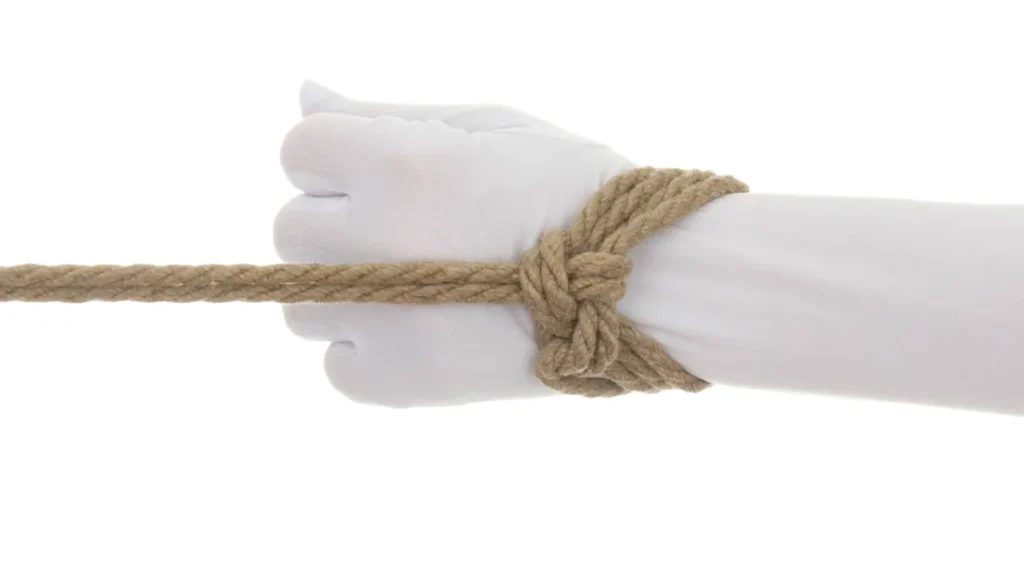
The Single Column Tie is one of the most fundamental knots in Shibari. It’s used to tie a single limb or body part to a stationary object or to secure a part of the body to another piece of rope.
How to Tie the Single Column Knot:
- Measure out an arm’s length of rope, and wrap it once around the limb you want to tie.
- Cross the rope over itself to create a loop and pull the tail through the loop.
- Pull the rope tight, ensuring that the tie is snug but not too tight to avoid cutting off circulation.
- Secure the knot by tying a simple overhand knot at the end.
Applications
The single column tie is used in various Shibari forms, from simple wrist ties to more complex body harnesses.
The Double Column Tie
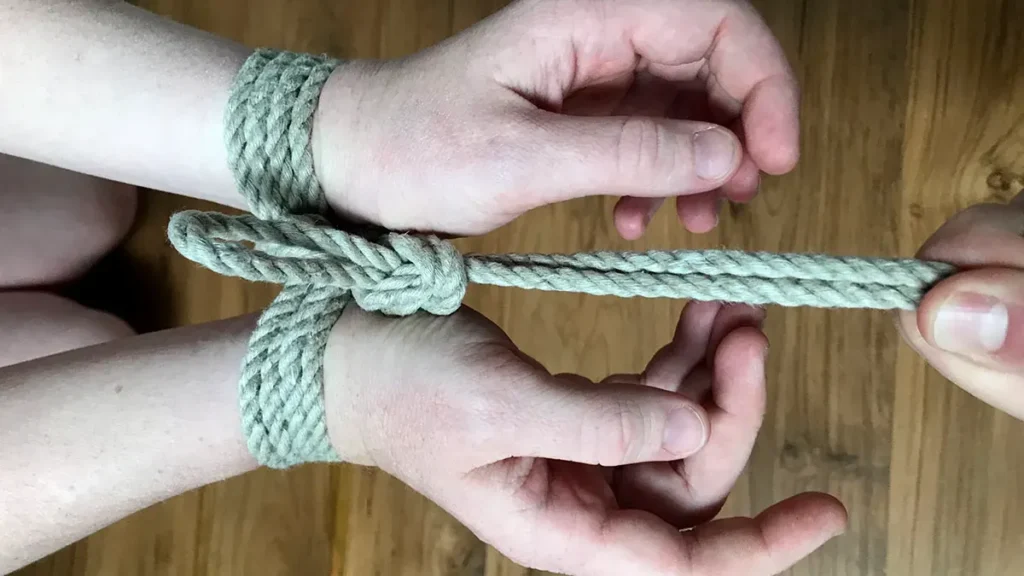
The Double Column Tie is similar to the single column tie but is used to bind two body parts together, such as wrists or ankles. It’s a versatile knot often used in both floor and suspension Shibari.
How to Tie the Double Column Knot:
- Measure out enough rope to wrap around both limbs twice.
- Wrap the rope around the two limbs, keeping the tension even.
- Cross the rope over itself and pull the end through the middle to form a loop.
- Tie an overhand knot to secure the tie in place.
Applications
This tie is ideal for binding wrists, ankles, or even legs together during suspension or floor work.
The Lark’s Head Knot
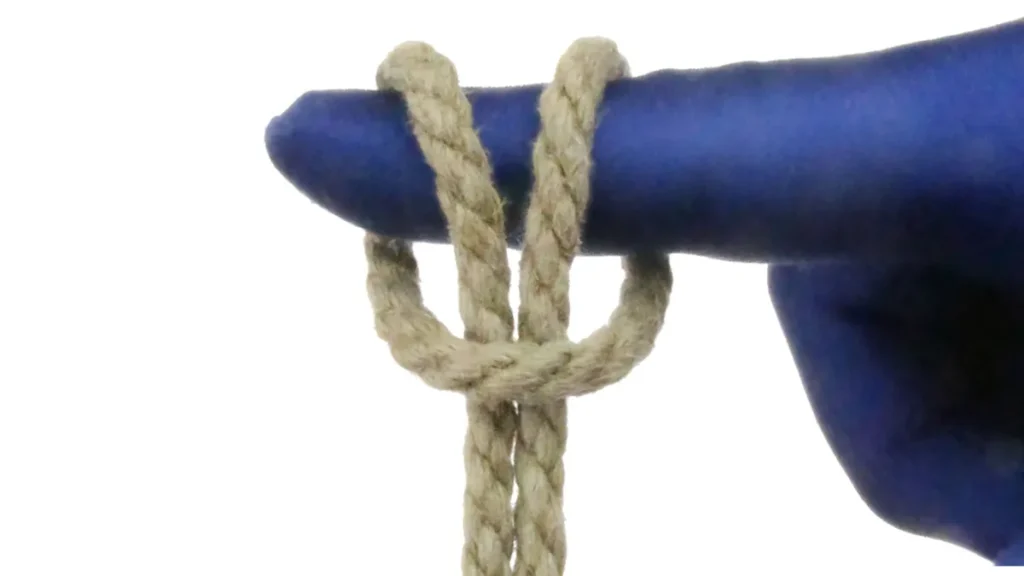
The Lark’s Head Knot is a simple and widely used knot in Shibari. It’s used to attach the rope to an anchor point, such as a bedpost or suspension ring.
How to Tie the Lark’s Head Knot:
- Fold the rope in half to create a loop.
- Pass the loop under the anchor point.
- Pull the two ends of the rope through the loop and tighten.
Applications
This knot is great for attaching ropes to suspension points or securing parts of the rope system.
Beginner Tying Techniques: Full Body Shibari
Once you have the basics of knotting down, it’s time to move on to simple, full-body Shibari techniques. These involve creating body harnesses or restraining different parts of the body in ways that are both functional and visually stunning.
The Chest Harness (Karada)

The Karada, or chest harness, is one of the most iconic Shibari ties. It wraps around the chest and torso, creating a diamond-shaped pattern that’s both beautiful and functional.
How to Tie the Karada:
- Start by tying a single column knot around the torso, just beneath the chest.
- Wrap the rope around the body in even loops, creating a symmetrical pattern.
- Cross the rope in the front and back to form diamond shapes as you continue wrapping.
- Secure the tie at the base of the spine or the front, ensuring the model is comfortable.
Applications
The Karada can be used for both floor and suspension Shibari and can be worn beneath clothing or on its own for aesthetic purposes.
The Crotch Rope (Matanawa)
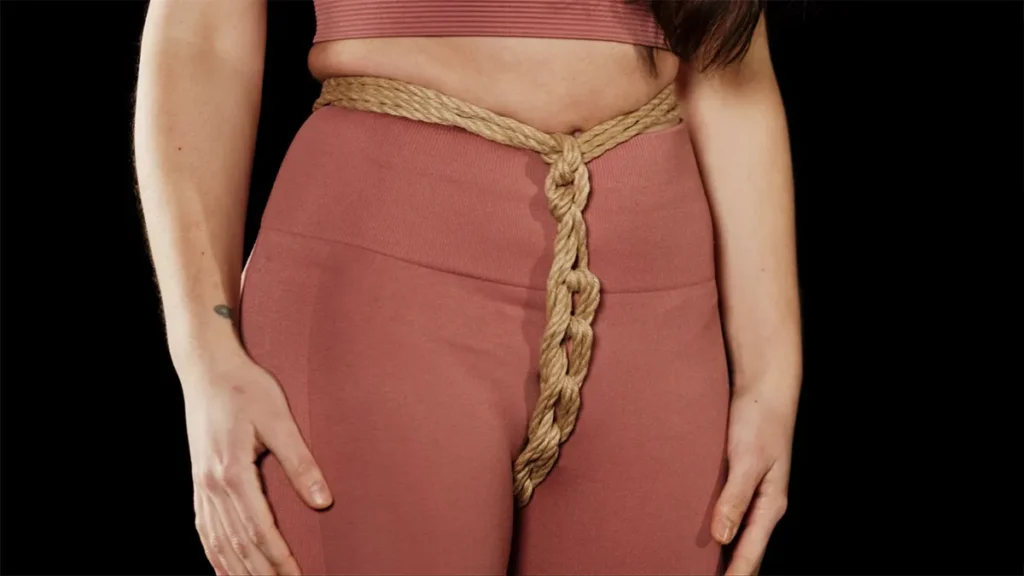
The Matanawa, or crotch rope, is a tie that runs between the legs and around the waist, creating pressure in sensitive areas.
How to Tie the Matanawa:
- Start by tying a single column knot around the waist.
- Pass the rope between the legs and bring it back to the waist, pulling gently to apply pressure.
- Wrap the rope around the waist again and repeat the process until the desired pressure is achieved.
Applications
This tie is often used in combination with other harnesses, and it adds a layer of sensation that can enhance both erotic and aesthetic elements of Shibari.
Limb Tying and Suspension Preparation
As you grow more comfortable with Shibari basics, you may want to explore more advanced techniques, such as limb tying and preparing for suspension. Limb ties are an important aspect of Shibari, often leading to the breathtaking imagery associated with full-body suspension. However, even without suspending, limb ties can be an intense and rewarding experience.
Limb Tying for Ground Play
Limb tying focuses on securing specific parts of the body—like arms, legs, or thighs—to themselves or each other. The sensation of restricted movement can enhance the feelings of vulnerability and trust, which are central to Shibari.
How to Tie the Ankles or Wrists:
- Start by using a double column tie around the wrists or ankles, ensuring that there is enough slack to avoid cutting off circulation.
- Bind the wrists or ankles together using even tension, creating a secure but comfortable hold.
- For added restriction, secure the tied wrists or ankles to a fixed object, such as a bedpost or anchor point.
Applications
This tie can be used in floor-based Shibari play, making it easier for the bottom to remain comfortable while still experiencing the sensations of restriction.
Suspension Preparation: Tying for Safety
Suspension is one of the most advanced and visually captivating forms of Shibari. It involves lifting the bottom off the ground using ropes and securing them in midair. Suspension requires a deep understanding of safety, technique, and communication between the top and bottom.
How to Prepare for Suspension:
- Start with Partial Suspension Before diving into full suspension, practice partial suspension techniques. For example, tie the legs or upper body, while keeping part of the body grounded.
- Use Strong Anchor Points Make sure that the suspension ring, beam, or anchor point is rated for the weight it will be supporting. Always test the equipment before proceeding.
- Distribute Weight Evenly When tying for suspension, ensure the body’s weight is evenly distributed across multiple points to avoid strain or injury. The chest, thighs, and hips are common weight-bearing areas in suspension Shibari.
Applications
Even if full suspension isn’t part of the session, tying limbs or parts of the body to a fixed point creates a sense of dynamic tension that can enhance both the aesthetic and physical sensations of Shibari.
Applications
Shibari as an Art Form
Shibari isn’t just a form of restraint—it’s an art. The intricate patterns and tension between rope and skin create a beautiful visual display, while also forming a deeper emotional connection between the top and bottom. The body becomes a canvas, and the rope an extension of the artist’s hands.
Aesthetic Symmetry in Shibari
One of the key aspects of Shibari’s visual appeal is symmetry. The way the rope is tied across the body can emphasize the natural lines of the human form, enhancing its beauty.
Why Symmetry Matters:
- Balance A symmetrical tie creates a sense of balance, making the bondage look elegant and deliberate.
- Tension Proper tension is necessary to achieve both functional and aesthetic balance, ensuring the ropes are tight enough to hold but not so tight as to cause discomfort.
Tips for Symmetry:
- When creating body harnesses, focus on keeping the rope evenly spaced on each side of the body.
- Ensure that the rope is lying flat against the skin without twisting, which enhances the visual symmetry.
Incorporating Movement and Flexibility
Shibari allows for movement, even when the bottom is fully restrained. The ropes create tension that can accentuate body flexibility, enabling the bottom to arch or move within their limits.
How to Incorporate Movement:
- As the top, encourage your partner to explore their flexibility by gently moving within the ties.
- Pay attention to how the ropes shift as your partner moves, making adjustments as needed to keep the tension even and comfortable.
Applications
In Shibari photography, these movements can be captured to show the dynamic relationship between rope and skin, creating a fluid and artistic pose.
Photography and Shibari
Shibari’s aesthetic appeal makes it a popular subject for photography. Capturing the intricate ties, the emotions of the bottom, and the tension between partners can result in stunning visual art.
Tips for Shibari Photography:
- Lighting Soft lighting can highlight the texture of the rope against the skin, while dramatic lighting can emphasize the shadows and contours of the body.
- Angles Shoot from various angles to capture the full effect of the ties. Close-ups can showcase the intricacy of the knots, while wider shots emphasize the entire body and rope pattern.
Applications
In Shibari photography, these movements can be captured to show the dynamic relationship between rope and skin, creating a fluid and artistic pose.
Safety and Consent in Shibari
Shibari, like all forms of bondage and BDSM, requires a foundation of trust, communication, and consent. Without clear communication and an understanding of safety, the experience can quickly become uncomfortable or even dangerous. Safety should always be prioritized above all else.
Consent and Communication
Consent is an essential component of Shibari. Both the top and bottom must clearly communicate their boundaries, limits, and desires before beginning a session. Consent should be ongoing and can be withdrawn at any point if either partner feels uncomfortable.
How to Ensure Continuous Consent:
- Pre-Tie Negotiation Before the session, discuss what both partners are comfortable with. This can include which parts of the body will be tied, what kind of pressure is acceptable, and what type of play (sensory, erotic, or artistic) is the focus.
- Constant Check-Ins During the session, constantly check in with your partner. Ask how they’re feeling, if the tension is too much, and whether they need a break.
-
Use of Safe Words
Establish safe words (like “yellow” for caution and “red” for stop) to signal if anything becomes too intense. Safe gestures should also be established if the bottom is gagged or unable to speak.
You can read the Consent and Communication in BDSM article posted here for more information.
Recognizing Warning Signs
Even with careful communication, issues can arise. It’s important to be able to recognize warning signs that indicate something is wrong.
Physical Warning Signs:
- Numbness or Tingling If the bottom experiences numbness or tingling in their limbs, this could indicate restricted circulation. The ropes should be loosened immediately.
- Discoloration Check for changes in skin color, especially in areas that are tied. Blue or purple skin can indicate a lack of blood flow.
- Cold Extremities Cold hands or feet may suggest that the ropes are cutting off circulation and need to be adjusted or removed.
Emotional Warning Signs:
- Discomfort or Panic If the bottom appears anxious, uncomfortable, or begins to panic, stop immediately and provide comfort.
- Loss of Communication If the bottom stops responding to check-ins or seems to withdraw emotionally, untie them and check in.
Post-Tying Aftercare
Aftercare is a vital part of any Shibari session. The intensity of being tied, both physically and emotionally, can leave the bottom feeling drained or vulnerable. Aftercare helps to soothe these feelings and reinforce the connection between partners.
Aftercare Tips:
- Comfort and Reassurance Offer blankets, water, or snacks to help the bottom recover. Reassure them of their safety and take time to cuddle or talk.
- Massage and Stretching Gently massaging the areas where the ropes were tied can help alleviate tension or soreness. Stretching can also help the bottom regain mobility.
- Discuss the Experience Take time to talk about the session. Ask your partner how they felt, what they enjoyed, and what could be improved next time.
Advanced Shibari Techniques
Once you’ve mastered the basics of Shibari, you may want to explore more advanced techniques, such as suspension and complex knots. These techniques require a deeper understanding of body mechanics, rope tension, and safety.
The Futomomo Tie
The Futomomo is a beautiful and functional leg tie that binds the calf to the thigh. It’s commonly used in both floor work and suspension and can be a rewarding tie for intermediate Shibari practitioners.
How to Tie the Futomomo:
- Start by tying a single column knot around the ankle.
- Bring the rope up to the thigh and wrap it around the leg in even loops.
- Cross the rope over the knee and secure it with a half-hitch.
- Continue wrapping the rope around the calf and thigh, ensuring the tension is even.
Applications
The Futomomo tie is commonly used in partial suspension, where the bottom’s legs are tied while their upper body remains grounded.
Shibari Suspension: An Introduction
Suspension is one of the most challenging yet visually stunning forms of Shibari. It involves lifting the bottom off the ground using ropes, which requires an in-depth understanding of knots, body positioning, and safety.
Tips for Starting Suspension:
- Use Strong Support Always ensure your suspension point is secure and rated for weight. Test the rigging multiple times before proceeding.
- Partial Suspension First Before trying full suspension, practice with partial suspension, where only a part of the body is lifted off the ground. This allows you to get comfortable with the dynamics of rope tension and weight distribution.
- Focus on Comfort Suspension can place a lot of strain on the body. Regularly check in with the bottom to make sure they’re comfortable and not experiencing any pain or numbness.
Combining Shibari with Other BDSM Elements
As you progress with Shibari, you might find that incorporating other elements of BDSM can enhance the experience, creating a multi-sensory or power dynamic-driven scene. Combining Shibari with impact play, sensory deprivation, or role-playing can deepen the intensity and connection between partners.
Shibari for Intimacy and Connection
One of the most profound aspects of Shibari is how it can deepen intimacy and connection between partners. The act of tying someone, or being tied, requires trust, communication, and vulnerability. These elements make Shibari a powerful tool for exploring emotional and physical closeness.
Rope as a Tool for Building Trust
Shibari is a physical manifestation of trust. The bottom places their body in the hands of the rigger, trusting them to tie safely, securely, and with care. This exchange of control can lead to a deeper emotional connection between partners.
How Shibari Builds Trust:
- Physical Surrender By surrendering to the ropes, the bottom is literally giving control of their body to their partner. This can create a powerful bond as they trust the top to maintain safety and comfort.
- Emotional Vulnerability The vulnerability of being tied can lead to deeper emotional intimacy. For some, the act of being restrained allows them to let go of control and be emotionally open in ways they might not be otherwise.
- Continuous Communication The constant checking in and feedback between partners during a Shibari session reinforces trust. This ongoing dialogue ensures that both partners feel safe and heard.
Using Shibari to Explore Power Exchange
At its core, Shibari is often about the power exchange between the top (rigger) and the bottom (model). The top has control over the ropes and the body of the bottom, while the bottom submits to the experience. This power dynamic can be incredibly intimate and rewarding for both parties.
How Power Exchange Manifests in Shibari:
- Dominance and Submission The act of tying someone can be a dominant act, while being tied can be a submissive one. The exchange of control deepens the emotional connection and can enhance feelings of trust and vulnerability.
- Mutual Exchange Although the top is in control of the ropes, the bottom still has power in the dynamic. By giving feedback, expressing their boundaries, and communicating throughout the session, the bottom plays an active role in shaping the experience.
Application
This power dynamic is often explored within BDSM relationships, but it can also be a way for non-BDSM practitioners to explore new layers of their relationship, deepening emotional and physical trust.
The Emotional Journey of Shibari
For many, Shibari is more than just physical restraint. It can be an emotional experience, leading to catharsis, self-discovery, and personal growth. Being tied can lead the bottom through a journey of vulnerability, release, and, sometimes, emotional healing.
How Shibari Can Be Emotionally Transformative:
- Catharsis Through Surrender For some bottoms, the act of surrendering to the ropes can bring about a deep emotional release. This catharsis can be akin to the emotional release felt in other forms of BDSM or even therapy.
- Heightened Connection The intense focus on the connection between the rigger and model can lead to an emotional high for both parties. This is sometimes referred to as “rope space,” a meditative or heightened emotional state induced by the physical and emotional intensity of the Shibari session.
- Exploration of Self For both the top and bottom, Shibari can be a way of exploring deeper aspects of their identity, desires, and emotional responses. Whether it’s the thrill of control, submission, or simply the sensation of the ropes, Shibari can offer personal insights and growth.
Myths and Misconceptions About Shibari
There are several misconceptions about Shibari that can deter people from exploring this beautiful and intimate art form. By debunking these myths, more people can experience the depth, artistry, and connection that Shibari has to offer.
Shibari is Painful or Dangerous
One of the most common misconceptions is that Shibari is inherently painful or dangerous. While any form of bondage carries risks if not done properly, Shibari, when practiced with care, is designed to be safe and enjoyable.
Clarifying the Misconception:
- It’s About Control, Not Pain Shibari is more about the control and restraint rather than pain. The ropes should not cut into the skin or restrict circulation if tied correctly. Always ensure that ties are snug but not too tight, and use soft, natural fiber ropes that won’t cause abrasions.
- Safety First With proper knowledge and safety practices, Shibari can be a safe and intimate experience. Always keep safety shears nearby, check circulation regularly, and maintain open communication with your partner.
Shibari is Only for BDSM Practitioners
While Shibari is often associated with the BDSM community, it doesn’t have to be limited to those who practice BDSM. Many people engage in Shibari for the aesthetic beauty, the emotional connection, or simply as an artistic form of expression.
Explaining Its Broader Appeal:
- Aesthetic Appeal Shibari’s artistic beauty is one of its most attractive features. The intricate knots, the symmetry of the ties, and the way the ropes accentuate the body’s natural curves make Shibari appealing for those interested in art and design.
- Intimacy and Connection For couples looking to deepen their connection, Shibari offers a way to explore trust, vulnerability, and physical closeness without necessarily engaging in BDSM dynamics.
Applications
Whether practiced as part of a BDSM scene, as a form of intimate play, or purely for its artistic beauty, Shibari can be tailored to fit a wide variety of desires and preferences.
Conclusion
Shibari is a multifaceted art form that transcends the physical act of bondage. It is about connection, vulnerability, trust, and artistic expression. Whether you’re a beginner learning the basics or an advanced practitioner exploring complex suspensions, Shibari offers a rich and rewarding experience for both the top and bottom. With proper safety measures, open communication, and a sense of exploration, Shibari can deepen emotional intimacy, elevate aesthetic beauty, and create unforgettable shared experiences between partners.
FAQs
What type of rope is best for beginners in Shibari?
Natural fiber ropes like jute or hemp are ideal for beginners due to their grip and texture, though synthetic ropes can be softer for sensitive skin.
Is Shibari only for people in BDSM relationships?
No, Shibari can be enjoyed by anyone interested in exploring rope bondage for artistic, intimate, or emotional reasons, whether they engage in BDSM or not.
What safety precautions should I take when practicing Shibari?
Always have safety shears on hand, communicate openly with your partner, check circulation regularly, and avoid tying too tightly or in sensitive areas.
Can I practice Shibari alone?
Some people do self-tying (self-Shibari), but it’s important to be very cautious and aware of the risks, especially when tying areas that affect circulation.
What is the emotional appeal of Shibari?
Shibari can create a deep emotional connection through vulnerability, trust, and the power exchange between the rigger and the model, offering a cathartic or healing experience.



